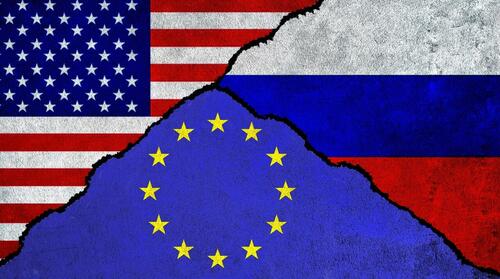Regional Conflict Vs World War III?
Authored by Daniel Oliver via American Greatness,
In a recent National Review, John O’Sullivan makes a compelling case for aiding Ukraine but not a convincing one. There are several problems, and they are worth rehashing one more time before the election.
If Trump wins, we know what happens.
If Harris wins, we really have no idea what will happen.
She is likely to bungle along as our current mentally challenged president has for the last two years: sandwiched between her anti-Semitic supporters and a lot of traditional Jewish Democrat supporters who – for some reason, no one (not even Norman Podhorets in the 352 pages of his 2010 book, Why Are Jews Liberals) has quite been able to explain – still vote Democrat.
O’Sullivan’s chief argument is the Hitler comparison: before World War II began, no one really believed that Hitler would sweep across Europe. But he did. And so, the thinking goes, will Putin. Maybe. But maybe not.
O’Sullivan writes:
“At their last summit meeting in Istanbul in November 1999, President Bill Clinton was surprised to be asked by Russian president Boris Yeltsin: Why don’t we agree that Russia can have Europe while the U.S. gets the rest of the world? His exact words were, ‘I ask you one thing. Just give Europe to Russia. The U.S. is not in Europe. Europe should be the business of Europeans. Russia is half European and half Asian.’”
“Andrei Illarionov, who was Putin’s economic adviser for several years (and a very successful one), has on several occasions testified that the Russian president has a well-worked-out long-term strategy to divide continental Europe from America and the U.K., to reach a Treaty of Rapallo–like agreement with Germany and France, and subsequently to wage a long campaign of subversion to weaken the Anglosphere powers.”
O’Sullivan also notes the amount of Russian spending on its military:
“The most conservative estimate of Russian spending is 6.5 percent of GDP. Other estimates go as high as 14 percent—though [O’Sullivan concedes] recent events suggest that President Putin is not getting a good bang for his buck.”
Those are not uninteresting points, but as O’Sullivan also concedes, Putin’s military seems to be second-rate, at best.
“If Russia is struggling to defeat Ukraine and even to defend its territory from Ukrainian advances, then it’s very clear that Russia could never win a conventional war against NATO.”
Yes, but: could it win a conventional war against Europe without the U.S.’s NATO contribution?
What should the U.S. do? And whatever the U.S. does, should it do it for Europe or only, or at least primarily, for the U.S.?
If it is so obvious that Putin really intends to gobble up much of Europe, why don’t the Europeans gird their loins, fasten on their breastplates, and get ready for war?
At a meeting of sophisticated policy types in Europe a few weeks ago, one European “reminded” the gathering that in 2008, the GDP of the U.S. and Europe were about equal. Today, the U.S. GDP is 75 percent larger. Not only that, Europeans are enacting laws designed to restrict U.S. companies from doing in Europe the things that have made the U.S. GDP so much larger than the EU’s GDP. The Wall Street Journal ran a piece making the same points on October 15.
So what? So the Europeans claim they don’t have the economic muscle to fight Putin alone and therefore need U.S. assistance. What’s wrong with that picture?
But there’s more. In the Summer 2024 issue of The Claremont Review, Christopher Caldwell notes that France plans to reduce its manpower in Central and West Africa (where it has been booted out of one country after another) to 600 troops and asks, “So how does it propose to join the Ukrainians in a major European ground war against Russia, which has several hundred thousand troops who have withstood an American proxy war for the better part of three years?”
And, writes Caldwell, “If you exclude [Britain’s] nuclear deterrent, its military spending has fallen to 1.8 percent; Britain is now spending less to defend itself than to pay the interest on its vast debt. In an interview with the Financial Times in early July, a former director of the British Ministry of Defence’s Office of Net Assessment judged the U.K. military unprepared for ‘conflict of any scale.’”
And “the Baltic states—Latvia, Lithuania, and Estonia—have fewer than 50,000 soldiers and not a single main battle tank.”
So Europe’s economy is in shambles and European countries don’t really have functioning armies. They could have better economies (if they tried the free market), which would enable them to have better armies. And the smart money is betting on that happening when pigs learn to fly.
Pending which, is the U.S. supposed to bail the Europeans out again?
In 1951, Eisenhower said, “If in ten years, all American troops stationed in Europe for national defense purposes have not been returned to the United States, then this whole project will have failed.” Did he sense that the Europeans wouldn’t bother to provide for their own defense?
A faux argument that has been trotted out by the Biden administration and other supporters of U.S. aid to Ukraine untutored in economics is that by spending gazillions of dollars on military hardware that we would then give to the Ukrainians, we are really helping America by paying American workers. But where does that money come from? Either from taxes on productive workers (when you tax an activity, you get less of it) or from loans to be paid off by our productive children and grandchildren. If paying some Americans to build bombs for Ukraine is such a good idea for America, why don’t we pay all American workers to build bombs for Ukraine?
One contribution the U.S. could make is to turn on its oil spigots—turned off by the climate crazy—and mentally challenged—Joe Biden, whose policy is surely supported by Kamala Harris. That would lower the world price of energy and drastically decrease Russia’s revenue—and wouldn’t cost the U.S. a cent.
Over the last decade, oil and gas have provided the largest single source of revenue for the Russian government, accounting for up to 50 percent of Russia’s budget.
In October 2024, Alexandra Prokopenko, an economist at the Carnegie Endowment for International Peace, estimated that “at current exchange rates, a $20 fall in oil prices would lead to a 1.8 trillion ruble ($20 billion) fall in [Russia’s] revenues . . . equivalent to about 1 percent of Russia’s GDP.”
Flooding the market with oil would also create financial hardship and perhaps calamity for Iran too (yes, Virginia, there is a Santa Claus).
Trump would do that. Harris would not. (Vote early and often.)
Meanwhile, back on the global stage, the U.S. must turn its attention to the growing threat from China, a far more serious threat than Russia—a point O’Sullivan seems to disagree with. He writes: “It is inevitable that an America that is now, if anything, too aware of China’s challenge (having ignored it for too long) will move money and troops from Europe to counter that challenge.” Well, yes. Precisely.
O’Sullivan’s comparison of Putin to Hitler may be correct, but he underestimates the threat that China poses—and also, probably underestimates the benefit to Europe that containing China provides.
The U.S. can’t do everything, and the sooner the Europeans grow up and recognize that and then act on that recognition, the better off they—and we—will be.
Views expressed in this article are opinions of the author and do not necessarily reflect the views of ZeroHedge.
Tyler Durden
Thu, 10/31/2024 – 02:00
via ZeroHedge News https://ift.tt/YfxEhyQ Tyler Durden








